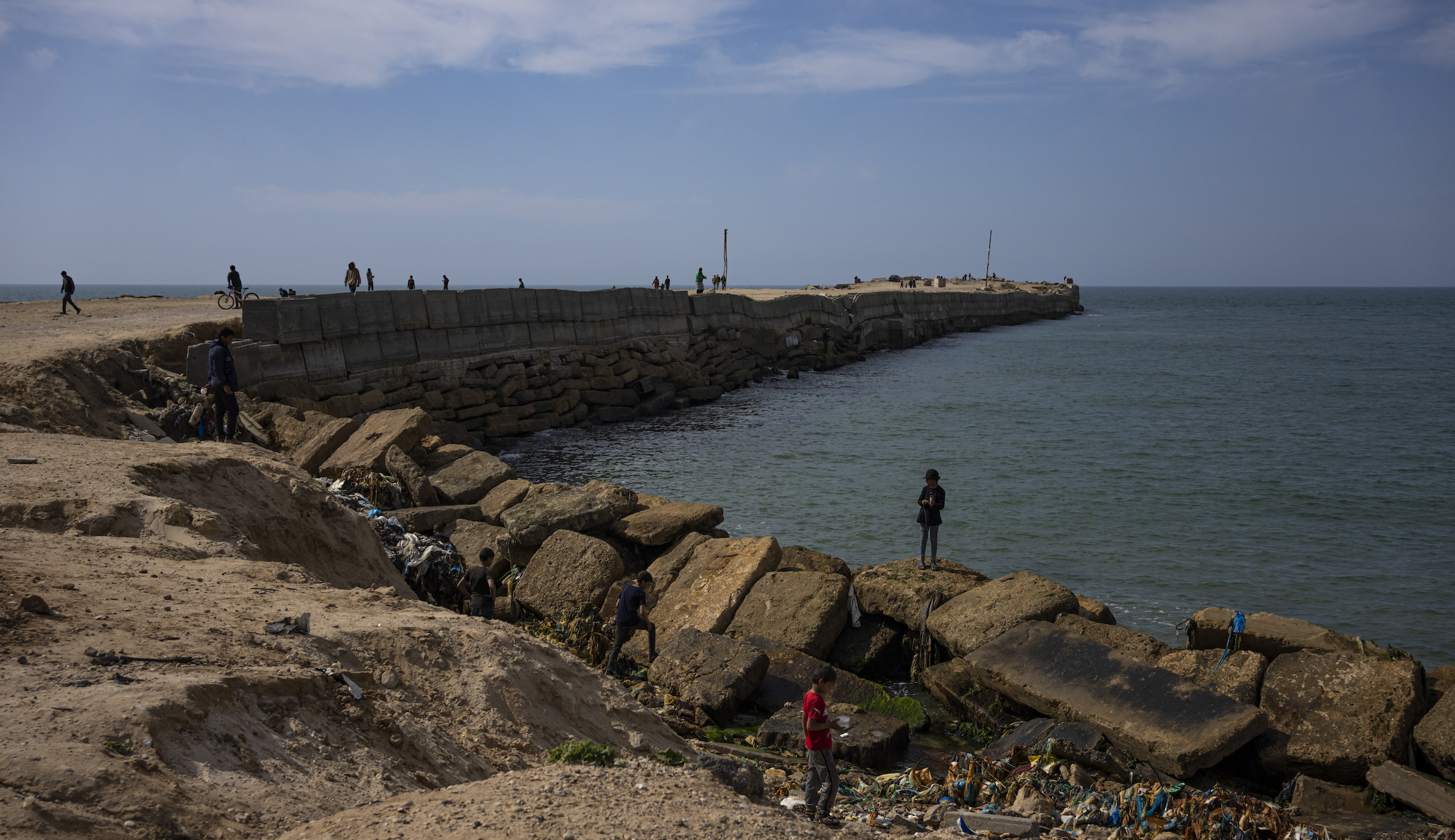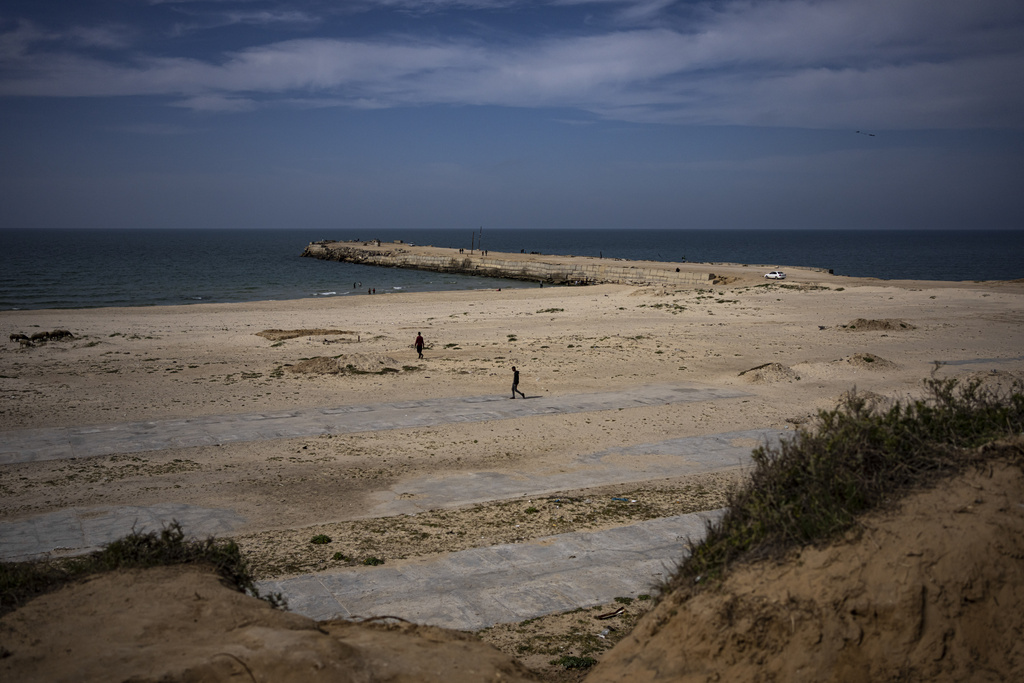


Israeli forces preparing for the U.S. military’s pier to be built off Gaza’s coast came under mortar fire this week, highlighting the threat posed to everyone involved in the plan to provide aid by sea.
On Monday, a “small number of mortars landed in the vicinity of the marshaling yard area” on the coast, according to Pentagon spokesman Maj. Gen. Patrick Ryder. U.S. forces who construct the pier and causeway will not be in Gaza. They will stay in the Mediterranean Sea and would not have been in the location where the mortars hit.
U.S. forces intend to build a pier anchored miles off Gaza’s coast and a causeway that will jut out from the Gaza coast into the Mediterranean Sea. Ryder said on Thursday that U.S. troops have begun construction of both, and the department expects the pier to be operational by early next month.
Humanitarian aid will travel to Cyprus, where it will be loaded onto commercial ships, travel roughly 200 miles from there to the floating pier, known as a Joint Logistics Over-the-Shore capability, or JLOTS, where it will then be loaded onto new vessels that will go from the pier to the causeway. Once the aid gets to the causeway, it can be transported to land via truck and distributed into Gaza.
U.S. forces will be involved in the transportation of the aid from the pier to the causeway, but they will not be driving the trucks of aid down the causeway, which will be “several hundred meters long,” according to a senior military official.
“First of all, when it comes to the temporary pier and the causeway, those are being constructed offshore, out at sea in our, you know, essentially nowhere near mortar range,” Ryder explained.
He said the mortar rounds hit “the marshaling yard where, eventually, in the vicinity of where this causeway will connect to. But the two essential pieces in the middle are the temporary pier, which is out at sea, and then the causeway, which eventually will join land and be anchored.”
No militant group took responsibility for the mortar fire at the port site, and there were no casualties, though there were United Nations officials who had to scramble for shelter. A Hamas official seemingly threatened any outside military forces in a recent interview with the Associated Press.
“We categorically reject any non-Palestinian presence in Gaza, whether at sea or on land, and we will deal with any military force present in these places, Israeli or otherwise … as an occupying power,” said Khalil al Hayya, a top Hamas political official.
While U.S. defense officials said U.S. forces will not be in Gaza, the attack highlights the dangerous environment they’ll be operating near, which U.S. military leaders have acknowledged.
“Nothing we do is risk-free,” Gen. Charles Q. Brown, chairman of the Joint Chiefs of Staff, said on Thursday.
“I feel strongly that it will be protected,” he added. “That doesn’t mean it won’t potentially have some threat against it, but it’s something we are focused on.”

Former Defense Secretary Mark Esper indicated he thinks the mission is more dangerous than current leaders are acknowledging for the roughly 1,000 troops involved.
“So they’re quite open to both direct fire, think about rifles and machine guns, but indirect fire, which are mortars and artillery,” Esper said on CNN. “And, of course, you could shoot mortars and artillery from miles and miles away without attribution and cause harm to U.S. forces, kill service members. If not that, you could destroy the pier quite easily and certainly disrupt operations.”
Sen. Roger Wicker (R-MS), the top Republican on the Senate Armed Services Committee, disagreed with President Joe Biden’s plan to build the pier when the president announced it last month during his State of the Union address, and he reiterated that criticism in light of the mortar attack.
“This attack was unfortunate but predictable,” he said. “This has been an ill-conceived mission from the start. Every day when these ships have been in transit was another day terrorists in Gaza have been preparing to thwart their arrival. In any case, the risk to Americans will only intensify. President Biden should never have put our men and women in this position, and he should abandon this project immediately before any U.S. troops are injured.”
The Israel Defense Forces will have a brigade of thousands of troops, including naval and air force assets, involved in protecting the causeway and marshaling yard.
CLICK HERE TO READ MORE FROM THE WASHINGTON EXAMINER
Biden decided to have the military build the pier, given the dire humanitarian situation facing Palestinian civilians.
Palestinians are facing significant humanitarian concerns, including the threat of famine and starvation. The entire population of Gaza, which is roughly 2.2 million people, faces acute food insecurity, more than half of the population in northern Gaza is facing catastrophic levels of food insecurity, nearly 30% of children in northern Gaza are showing signs of severe malnutrition, and nearly a quarter of the population in southern Gaza is facing catastrophic food insecurity, a senior administration official told reporters on Thursday.
